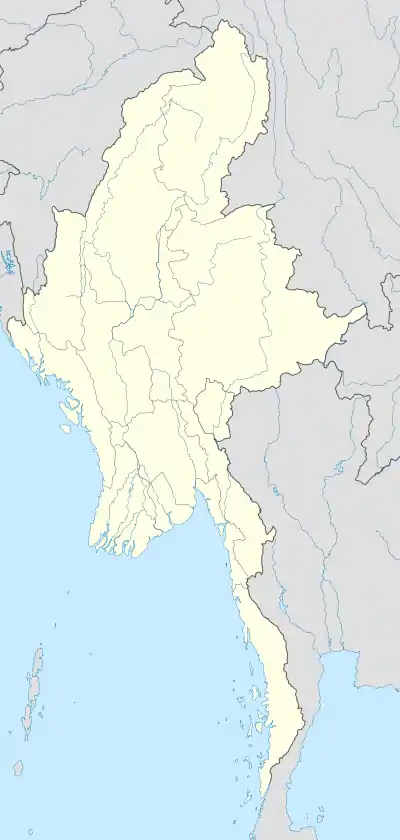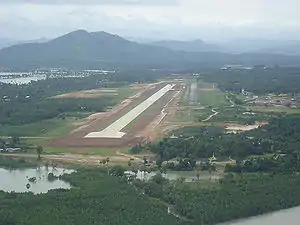Dawei
ထားဝယ် Tavoy | |
|---|---|
City | |
| Dawei | |
 | |
 Dawei Location in Myanmar (Burma) | |
| Coordinates: 14°05′0″N 98°12′0″E / 14.08333°N 98.20000°E | |
| Country | |
| Region | Tanintharyi Region |
| District | Dawei District |
| Township | Dawei Township |
| Capital | Dawei |
| Population (2014) | 146,964 |
| • Religions | Theravada Buddhism |
| Demonym | Dawegian |
| Time zone | UTC+6.30 (MMT) |
| Area code | 59[1] |
Dawei[2] (Burmese: ထားဝယ်; MLCTS: hta: wai, pronounced [dəwɛ̀]; Mon: ဓဝဲါ, pronounced [həwài]; Thai: ทวาย, RTGS: Thawai, pronounced [tʰā.wāːj]; formerly known as Tavoy) is a city in south-eastern Myanmar and is the capital of the Tanintharyi Region, formerly known as the Tenasserim Division, on the northern bank of the Dawei River. The city is about 614.3 km (381.7 mi) southeast of Yangon. Its population (2014 estimate) is 146,964. Dawei is a port at the head of the Dawei River estuary, 30 km (18.6 mi). from the Andaman Sea. As a result, the city is prone to flooding during the monsoon season. "Dawei" is also the name of one of Myanmar's 137 ethnic minorities.
Etymology
Dawei derives from the Mon language term hawai (Mon: ထဝဲါ; /həwai/), which means 'to sit cross-legged', in reference to the Buddha's sitting posture on the palin (throne).[3][4]
History
The area around the Dawei River estuary has been inhabited for centuries by Dawei, Mon, Kayin, and Thai mariners.
As the ancient site, Sagara City, old Dawei, which is approx 6 miles north of present city, has so many traces of Pyu culture, it was recognized as one of the province capital in ancient Pyu era.
From the 11th to 13th centuries, Dawei was part of the Pagan Empire. From 1287 to 1564, Dawei became part of the Sukhothai Kingdom and its successor Ayutthaya Kingdom (Siam). From 1564 to 1594, Dawei was part of the Toungoo Kingdom of Burma. Siam temporarily regained the city between 1594 and 1614. From 1614 to the 1740s, Dawei was the southernmost city under Burmese authority, and was defended by a Burmese garrison. In the late-1740s, during the Burmese civil war of 1740–1757, Dawei, along with the northern Tenasserim coast, was taken over by Siam. Burma regained the city in 1760, and extended its control over the entire Tenasserim coast in 1765. The Tenasserim coast was ceded to the British after the First Anglo-Burmese War (1824–1826).
After independence in 1948, the city became part of the Tenasserim Division, which also included today's Mon State. In 1974, Mon State was carved out of Tenasserim and Dawei became the capital of the truncated division. In 1989, the city's English name was changed from Tavoy to Dawei, and Tenasserim became Tanintharyi.
Climate
Dawei features an extreme tropical monsoon climate (Köppen climate classification Am), similar to Sittwe further north-west. There is a substantial dry season from November to March, but in the wet season the influence of local mountains causes Dawei to receive as much as 1,300 millimetres (51 in) precipitation per month. Apart from the Chocó region of Colombia, and the area around Mount Cameroon in Africa, it is possibly the wettest lowland tropical region in the world.
| Climate data for Dawei (1991–2020) | |||||||||||||
|---|---|---|---|---|---|---|---|---|---|---|---|---|---|
| Month | Jan | Feb | Mar | Apr | May | Jun | Jul | Aug | Sep | Oct | Nov | Dec | Year |
| Record high °C (°F) | 36.7 (98.1) |
37.5 (99.5) |
39.0 (102.2) |
39.5 (103.1) |
38.9 (102.0) |
36.1 (97.0) |
37.8 (100.0) |
34.5 (94.1) |
37.2 (99.0) |
37.2 (99.0) |
37.8 (100.0) |
37.5 (99.5) |
39.5 (103.1) |
| Mean daily maximum °C (°F) | 33.6 (92.5) |
34.5 (94.1) |
35.3 (95.5) |
35.5 (95.9) |
32.4 (90.3) |
29.9 (85.8) |
29.0 (84.2) |
28.8 (83.8) |
29.8 (85.6) |
32.2 (90.0) |
33.5 (92.3) |
33.3 (91.9) |
32.3 (90.1) |
| Daily mean °C (°F) | 26.0 (78.8) |
26.9 (80.4) |
28.3 (82.9) |
29.4 (84.9) |
28.0 (82.4) |
26.5 (79.7) |
25.8 (78.4) |
25.7 (78.3) |
26.2 (79.2) |
27.3 (81.1) |
27.1 (80.8) |
26.0 (78.8) |
26.9 (80.4) |
| Mean daily minimum °C (°F) | 18.5 (65.3) |
19.4 (66.9) |
21.3 (70.3) |
23.2 (73.8) |
23.6 (74.5) |
23.1 (73.6) |
22.6 (72.7) |
22.6 (72.7) |
22.6 (72.7) |
22.4 (72.3) |
20.7 (69.3) |
18.7 (65.7) |
21.6 (70.9) |
| Record low °C (°F) | 10.0 (50.0) |
10.6 (51.1) |
12.5 (54.5) |
16.8 (62.2) |
20.0 (68.0) |
20.0 (68.0) |
20.0 (68.0) |
20.0 (68.0) |
20.5 (68.9) |
16.7 (62.1) |
11.1 (52.0) |
8.9 (48.0) |
8.9 (48.0) |
| Average precipitation mm (inches) | 9.5 (0.37) |
14.6 (0.57) |
40.9 (1.61) |
111.4 (4.39) |
541.7 (21.33) |
977.4 (38.48) |
1,339.4 (52.73) |
1,325.1 (52.17) |
807.7 (31.80) |
259.0 (10.20) |
52.2 (2.06) |
6.7 (0.26) |
5,485.7 (215.97) |
| Average precipitation days (≥ 1.0 mm) | 1.0 | 1.4 | 3.5 | 5.6 | 20.1 | 26.9 | 28.8 | 28.3 | 24.9 | 16.6 | 3.9 | 0.9 | 161.9 |
| Source 1: World Meteorological Organization[5] | |||||||||||||
| Source 2: Sistema de Clasificación Bioclimática Mundial (records),[6] Ogimet.com | |||||||||||||
Transport
Only recently was Dawei connected to the rest of Myanmar by road and rail. A transnational highway and a railway line across the Tenasserim Hills connecting Dawei and Bangkok[2] are planned if a proposed deep water port project goes ahead.[7] This port could significantly reduce Singapore-bound traffic when completed.[8]
Dawei Airport
The airport serves as the domestic airport for the city of Dawei and the neighbouring towns. The government plans to upgrade the airport to serve as a hub for tourism.
Dawei Railway Station
It is the southernmost station and terminus in Myanmar. However the railway was partly constructed for a further 40 km approximately to the south towards Min Dat bridge and south Myanmar. Work ceased on this line in about 2012 but several partly constructed sections with bridges over rivers are visible on Google Earth.
Economy
There are plans to construct a deep water port in Dawei.[9] In November 2010, the Myanmar Port Authority signed a US$8.6 billion deal with Italian-Thai Development to develop the seaport at Dawei.[10] The Dawei Special Economic Zone would become Myanmar's first special economic zone (SEZ), which includes plans to develop a 250 square kilometres (97 sq mi) industrial estate, with sea, land (railway and road) infrastructure links to Thailand, Cambodia, and Vietnam, as well as a gas pipeline to Thailand's Kanchanaburi Province and commercial and residential developments.[11][12]
The development of the SEZ has been linked to land confiscations and land grabs from farmers of upwards of 63,768 acres (25,806 ha) (direct) and 153,919 acres (62,289 ha), potentially displacing 500,000 Dawei natives.[13] The project has been opposed by a significant portion of the local ethnic population.[14]
Dawei longyis (sarong) are one of the area's well-known products.[15] The area produces rubber, dried fish, and teakwood. It also produces cashew nuts and betel nuts and exports them through local traders to China, India, and Thailand. Dawei is also known for its variety of tropical fruits such as pineapples, a variety of mangoes, mangosteens, and durian. There is one fruit called zin thi (in Dawei language), which can only be found in Dawei and surrounding areas.
Higher education
- Dawei Education College
- Dawei University
- Technological University, Dawei
- Computer University, Dawei
- Government Agricultural Institute, Dawei
- Nursing Training School
Notable sites
- Maungmagan Beach
- Maungmagan Hot Springs
- Shwe Taung Sar Pagoda, Payagyi
- Pe Hot Springs
- Launglon Bok Islands
- Paradise Beach
- Grand Father Beach
- Sin Htauk Beach
- Wa Zwam Chaung Waterfall and hot springs
- Ka Lone Htar Creek
- Sargara Ancient City (Old town of the present Dawei)
- Mokhti Ancient City
- Thayet Chaung Waterfall
Notable residents
- Ba Swe, 2nd Prime Minister of Union of Burma
- Richard Bartholomew
- Ngwe Gaing, Burmese artist
- Ma Chit Po, only woman to be awarded the Thura Medal
See also
- List of railway stations in Myanmar
- Phu Nam Ron (Htee Kee)
References
- ↑ "Myanmar Area Codes". Archived from the original on 2009-12-01. Retrieved 2009-04-10.
- 1 2 "Dawei Road could endanger forests and wildlife - Report". Burma News International. 12 July 2019. Retrieved 3 August 2019.
- ↑ Tun, Than (1988). "Observations on the Translation and Annotation of the Royal Orders Of Burma". Crossroads: An Interdisciplinary Journal of Southeast Asian Studies. 4 (1): 91–99. JSTOR 40860260.
- ↑ Banyar, Ko (7 November 2013). "မွန်တို့ဌာနေ ရာမည တိုင်းက မွန် အခေါ်အဝေါ်များ". Phophtaw News Association. Archived from the original on 26 June 2015.
- ↑ "World Meteorological Organization Climate Normals for 1991–2020". World Meteorological Organization. Retrieved 16 October 2023.
- ↑ "Tavoy (Myanmar)" (PDF). Centro de Investigaciones Fitosociológicas. Retrieved 13 December 2018.
- ↑ "Table A1-1-1a. Prospective projects in Mekong sub-region" (PDF). Archived from the original (PDF) on 2013-05-04. Retrieved 2012-12-28.
- ↑ Narayan, Ranjana (12 August 2013). "India to link Myanmar port to boost connectivity with ASEAN". SME Times.
- ↑ "China's horizons extend southwards". Railway Gazette International. 4 January 2011. Retrieved 2011-01-06.
- ↑ Aye Thidar Kyaw; Stuart Deed (7 February 2011). "SPDC signs Special Economic Zone law into effect on Jan 27". Myanmar Times. Archived from the original on 16 September 2011. Retrieved 23 August 2011.
- ↑ Thein Linn (4 November 2010). "Dawei deep-sea port, SEZ gets green light". Myanmar Times. Archived from the original on 31 August 2011. Retrieved 23 August 2011.
- ↑ Calderon, Justin (30 October 2012). "Italian-Thai takes lead in delayed Dawei". Investvine.com. Retrieved 2013-02-27.
- ↑ Loewen, Elizabeth (September 2012). "Land Grabbing in Dawei (Myanmar/Burma): a (Inter)national Human Rights Concern" (PDF). Transnational Institute.
- ↑ Wangkiat, Paritta (25 May 2020). "Thai TV series give ugly truths a rosy hue" (Opinion). Bangkok Post. Retrieved 25 May 2020.
- ↑ "Dawei Traditional Longyi Weaving Art inc. video". Archived from the original on 2007-10-06.


